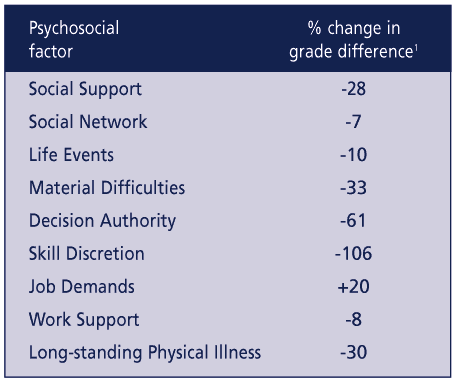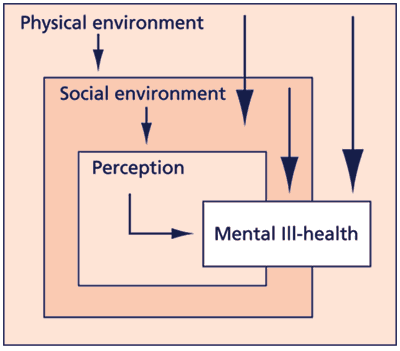 |
Close
window to return
|
Issue 4, July 1999, pp.4-5.
Psychosocial factors
and the explanation of socio-economic gradients in common mental disorder
Stephen Stansfeld, Rebecca Fuhrer, Victoria Cattell, Jane Wardle
and Jenny Head
Introduction
Socio-economic inequalities in physical illness, such as coronary heart
disease, are well known. There is also increasing evidence of inequalities
in common mental disorders including depressive disorders, anxiety disorders
and substance abuse.(1,2) However, not all studies find consistent social
class gradients in mental ill-health. This may relate to types of common
mental disorder having different social class distributions, different
characteristics of the populations studied and the tendency for the reporting
of psychological symptoms to vary by social class.(3)
Explanations for social inequalities
Research on inequalities in physical illness suggests that health-related
behaviours including smoking, an unhealthy diet and lack of exercise explain
only part of the class gradient. Thus psychosocial factors, such as social
relations and work characteristics, have been invoked by researchers as
possible additional explanatory factors for social gradients in physical
illness. In particular, low control at work ( decision authority) has
been found to explain statistically the gradients in self-reported coronary
heart disease among British civil servants in the Whitehall II Study.
It is not clear whether the same psychosocial factors might also explain
the gradients in common mental disorder. Preliminary analyses of the Whitehall
II study suggest that this may be the case: both control at work and skill
discretion (variety of work and opportunity for use of skills) are the
most important explanatory variables for the social gradient in depressive
symptoms in men(2) (see Table 1).
Table 1:Percentage change in grade difference in depression in men
by psychosocial factors,
(Whitehall II Study)

1.The percentage change in grade difference was calculated by including
grade as a linear term in a regression analysis and comparing the regression
coefficients for grade both before and after adjustment for each psychosocial
factor. Both models were adjusted for age.
Describing psychosocial factors
The most obvious candidate mechanism for the operation of psychosocial
factors on health is the Stress Hypothesis in which ill-health results
from an imbalance of demands over resources. Psychosocial factors may
include both stressors (risk factors) and protective factors (resources)
in relation to health. Psychosocial factors may be specific to different
life domains, (i.e. control at work) or more general (long-term financial
difficulties). Stressors include life events (e.g. bereavement, job loss),
chronic major difficulties (e.g. long-term financial strain, poor housing,
depleted local facilities and resources, fear of neighbourhood crime and
violence, fear of racial assault), social isolation, negative interactions
in close relationships, high job demands and low job control. Conversely,
psycho-social factors may be protective: for example, social support at
home or at work, high levels of control over work and skill discretion.
Quantitative analysis can be used to study risk factors, including work
and social support, for the whole Whitehall II cohort to explain the employment
grade in depression (measured by the Composite International Diagnostic
Interview); qualitative research can facilitate an emphasis on the processes
involved in the associations between, for example, grade and health and
support and health. These relationships are not dissociated from the wider
social and historical context in which they take place. The focus on context,
which is offered by qualitative analysis, provides an opportunity to look
at complexity: at how and under what circumstances stressors and resources
interact.
Unresolved issues for psychosocial factors and health
There are a number of issues to be addressed in researching the association
between psychosocial factors and health (see Figure 1).
Figure 1: The impact of the physical environment and psychosocial factors
on mental ill-health: a schematic representation

Firstly, given that psychosocial factors are embedded in people's material
environments, is it possible and helpful to separate the two spheres of
influence? Secondly, is it necessary for psychosocial factors (e.g. low
control) to be consciously perceived for them to affect mental health.
Are psychosocial effects always psychologically mediated? It seems likely
that there might be social effects on behaviour and mental health that
are not consciously perceived, or at least, not consciously understood.
A third issue concerns the relative importance of exposure in childhood
and in adulthood to psychosocial stressors. Both Lundberg(4) and Power(5)
provide evidence to suggest that exposure to hardship in childhood may
be more important than adult psychosocial exposures in explaining socio-economic
differences in mental health. It remains unresolved, however, how much
childhood social class, and hence psychosocial stressor exposure in childhood,
shapes adult exposure to psychosocial stressors (see article by Amanda
Sacker, Health Variations Programme Newsletter, Issue 4, pp.8-10).
Fourthly, there are methodological issues to be addressed. If both stressors
and mental health outcomes are measured by self-reported questionnaire,
there is a risk that they might be subject to negative affectivity, that
is by a tendency to describe both one's exposure to psychosocial stressors
and one's mental health, in negative terms. Studies should measure negative
affectivity and take it into account in analysis. Another concern is that
psychosocial factors, such as control at work, may be confounded with
measures of social class, such as employment grade in the Whitehall II
Study. This may be the case to some extent, but the same explanatory association,
although less strong, is found between control and social class differences
in depression when social class is measured by access to a car and housing
tenure.(2) Furthermore, it may be incorrect to view control as a confounding
factor when it may be a mediating factor between class and health.
Project Aims
Our project (Determinants of Social Class Differences in Mental and Physical
Ill-health) aims to shed further light on the role of psychosocial factors
in explaining the socio-economic gradient in depression, through two linked
investigations based on the Whitehall II Study of civil servants. The
first aim of the project is a qualitative study, examining the dynamics
between stressors, supports and coping mechanisms in three specific contexts:
home, neighbourhood and work; and exploring the nature of these psychosocial
factors in a subsample to see if they differ qualitatively by social class
and to understand possible mechanisms.
Insights derived from the in-depth interviews will inform the second aim
of the study, based on a diagnostic interview measure of depression carried
out on the total cohort population of the Whitehall II Study.
Drawing on both the qualitative and quantitative studies, our project
will examine how constructs such as control at work or demands may differ
by employment grade (as our previous quantitative analyses suggest that
they may do ). It seems very likely that control may be interpreted differently
according to social class and gender(6) and further understanding of this
through qualitative analysis may throw new light on existing quantitative
findings. It will also look at differences in supportive resources. Although
social networks can provide many benefits, including a protective or direct
influence on mental health, these functions may vary according to certain
characteristics of the network.(7) Our study will explore structural aspects
of an individual's network, and will consider for example, the role of
weaker as well as stronger ties in either influencing or moderating inequalities
in mental health by grade or gender.
Conclusions
Understanding the role of psychosocial factors and how they differ by
socio-economic status may help to focus on which psychosocial interventions
are likely to be effective in improving population mental health. Determining
whether psychosocial risk factors are the same for both inequalities in
mental and physical ill-health will be informative in deciding whether
or not separate interventions to improve mental and physical health are
needed.
Stephen Stansfeld, Rebecca Fuhrer, Victoria Cattell, Jane Wardle and
Jenny Head are based at the Department of Epidemiology and Public Health,
Royal Free and University College Medical School, University College London.
References:
1. Lewis, G., Bebbington, P., Brugha, T., Farrell, M., Gill, B., Jenkins,
R. and Meltzer, H. (1998) 'Socio-economic status, standard of living,
and neurotic disorder' The Lancet, 352 pp.605-609.
2. Stansfeld, S. A., Head, J. and Marmot, M. G. (1998) 'Explaining social
class differences in depression and well-being'. Soc. Psychiatry. Psychiatr.
Epidemiol., 33 pp.1-9.
3. Stansfeld, S. A. and Marmot, M. G. (1992) 'Social class and minor psychiatric
disorder in British Civil Servants: a validated screening survey using
the General Health Questionnaire' Psychological Medicine, 22 pp.739-749.
4. Lundberg, O. (1991) 'Causal explanations for class inequality in health
- an empirical analysis' Social Science and Medicine, 32 pp.385-393.
5. Power, C. and Manor, O. (1992) 'Explaining social class differences
in psychological health among young adults: a longitudinal perspective'
Soc. Psychiatry. Psychiatr. Epidemiol., 27 pp.284- 291.
6. Ostergren, P. O., Lindbladh, E., Isacsson, S. O., Odeberg, H. and Svensson,
S. E. (1995) 'Social network, social support and the concept of control
- a qualitative study concerning the validity of certain stressor measures
used in quantitative social within epidemiology'. Scandinavian Journal
of Social Medicine, 23 pp.95-102.
7. Cattell, V. and Evans, M. (1999) Neighbourhood images in East London.
Social capital and social networks on two East London estates, York :
Joseph Rowntree Foundation pp.1-61.